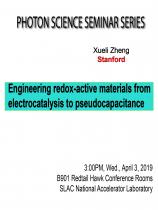Speaker: Xueli (Sherry) Zheng, Stanford
Program Description:
Redox-active materials represent the most promising prospect towards electrocatalytic systems and energy storage technologies. However, the poor understanding of redox chemistry at the molecular level limits the activity improvement and further industrial application.
I will first describe our research efforts on the synthesis of high valued chemicals and fuels from renewable electricity and CO2. We focus on developing, understanding, and eventually designing new catalysts for electroreduction of CO2 and water oxidation reaction using computational materials science, in situ/ex situ synchrotron X-ray spectroscopies, and advances in materials chemistry. Specifically, I will report a concept to engineering the redox chemistry by introducing isolated single sites and incorporating the third element to modulate the active species. Next, I will discuss the molecular insights to engineer the redox reactions for pseudocapacitance. We change the dominant charge storage mechanism from surface redox reactions to ion intercalation into bulk material by atomic-level structure engineering of metal oxides.





